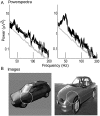Stimulus Dependence of Gamma Oscillations in Human Visual Cortex
- PMID: 24855114
- PMCID: PMC4537439
- DOI: 10.1093/cercor/bhu091
Stimulus Dependence of Gamma Oscillations in Human Visual Cortex
Abstract
A striking feature of some field potential recordings in visual cortex is a rhythmic oscillation within the gamma band (30-80 Hz). These oscillations have been proposed to underlie computations in perception, attention, and information transmission. Recent studies of cortical field potentials, including human electrocorticography (ECoG), have emphasized another signal within the gamma band, a nonoscillatory, broadband signal, spanning 80-200 Hz. It remains unclear under what conditions gamma oscillations are elicited in visual cortex, whether they are necessary and ubiquitous in visual encoding, and what relationship they have to nonoscillatory, broadband field potentials. We demonstrate that ECoG responses in human visual cortex (V1/V2/V3) can include robust narrowband gamma oscillations, and that these oscillations are reliably elicited by some spatial contrast patterns (luminance gratings) but not by others (noise patterns and many natural images). The gamma oscillations can be conspicuous and robust, but because they are absent for many stimuli, which observers can see and recognize, the oscillations are not necessary for seeing. In contrast, all visual stimuli induced broadband spectral changes in ECoG responses. Asynchronous neural signals in visual cortex, reflected in the broadband ECoG response, can support transmission of information for perception and recognition in the absence of pronounced gamma oscillations.
Keywords: broadband spectral change; electrocorticography; gamma oscillations; human electrophysiology; visual cortex.
© The Author 2014. Published by Oxford University Press. All rights reserved. For Permissions, please e-mail: journals.permissions@oup.com.
Figures






Comment in
-
Gamma Oscillations in a Bind?Cereb Cortex. 2015 Dec;25(12):4651-2. doi: 10.1093/cercor/bhu136. Epub 2014 Jul 1. Cereb Cortex. 2015. PMID: 25405937 No abstract available.
References
-
- Aguirre GK, Zarahn E, D'Esposito M. 1998. An area within human ventral cortex sensitive to "building" stimuli: evidence and implications. Neuron. 21:373–383. - PubMed
-
- Allison T, Ginter H, McCarthy G, Nobre AC, Puce A, Luby M, Spencer DD. 1994. Face recognition in human extrastriate cortex. J Neurophysiol. 71:821–825. - PubMed
-
- Bartolo MJ, Gieselmann MA, Vuksanovic V, Hunter D, Sun L, Chen X, Delicato LS, Thiele A. 2011. Stimulus-induced dissociation of neuronal firing rates and local field potential gamma power and its relationship to the resonance blood oxygen level-dependent signal in macaque primary visual cortex. Eur J Neurosci. 34:1857–1870. - PMC - PubMed
-
- Bauer R, Brosch M, Eckhorn R. 1995. Different rules of spatial summation from beyond the receptive field for spike rates and oscillation amplitudes in cat visual cortex. Brain Res. 669:291–297. - PubMed
Publication types
MeSH terms
Substances
Grants and funding
LinkOut - more resources
Full Text Sources
Other Literature Sources

